India’s August 2023: Driest and Hottest in Over a Century – Monsoon Deficiency Raises Concerns for Agriculture

August 2023 witnessed record-breaking dry and hot conditions across India. The Indian Meteorological Department (IMD) reported that it was the driest and warmest August in over a century, with historic lows in monsoon precipitation across central and southern regions.
Also read: Why has Northeast monsoon remained subdued this year?
Historic Drought Conditions
- August 2023 marked an unprecedented drought, with the lowest rainfall since 1901.
- Central India and the South Peninsular region experienced the driest monsoon in 122 years.
Extreme Heatwave:
- Average maximum and mean temperatures in India soared to their highest levels since 1901.
- August 2023 saw extreme heatwave conditions.
Monsoon Breaks and Impact:
- Two significant monsoon breaks occurred in August (5-16 and 27-31 August).
- The monsoon trough’s northward shift led to unfavorable conditions for plains’ rainfall.
- El Nino and unfavorable Madden Julian Oscillation adversely affected August’s rainfall.
September Forecast and Concerns:
IMD predicts normal to above-normal rainfall in September. Water reservoir levels have been falling, raising concerns for Kharif crops. Uneven monsoons already affect Kharif sowing, particularly in pulses.
Economic Impact and Inflation:
- Weak production may elevate food inflation.
- Government support measures like subsidized vegetable supply and reduced LPG prices could ease pressure.
Agricultural Challenges
- Pulse, groundnut, cotton, and jute prices may remain high due to deficient rainfall.
- Rice, despite higher sowing, faces pressure.
Reservoir Levels and Future Worries:
Water levels in key reservoirs have dropped significantly. Falling reservoir levels impact drinking water, cattle, and Rabi sowing.
Monsoon and the Economy:
Monsoon rains drive India’s economy, crucial for agriculture and power generation. Over 50% of India’s arable land relies on monsoon rainfall.
El Nino and IOD Influence:
- El Nino’s warming effect in the Pacific affects Indian monsoons.
- Positive Indian Ocean Dipole (IOD) may mitigate El Nino’s effects.
Monsoon Delay:
- Monsoon withdrawal from Southwest Rajasthan is delayed by around two weeks compared to the usual September 1st timeframe.
Also read: Apple’s Big Reveal: iPhone 15 and More
Conclusion:
India faces significant challenges following an extraordinary August. September’s rainfall will impact agriculture, reservoirs, and the economy.


